Hot Research Topics 2009
Hot Topics Home
2015 | 2014 | 20132012 | 2011
2010 | 2009 | 2008 | 2007 | 2006
Agricultural Research Service Information Staff's Image Gallery - a complimentary source of high quality digital photographs
Climate Change
 As CO2 Levels Rise, Plants and Humans Respond - Agricultural Research Service plant physiologist Lewis Ziska has found that poison ivy is thriving-and becoming more toxic-because of increased carbon dioxide (CO2) levels in the atmosphere. And when pollen wafts through the air, science pundits cite Ziska's work showing that global climate change is ramping up the production of ragweed allergens.
As CO2 Levels Rise, Plants and Humans Respond - Agricultural Research Service plant physiologist Lewis Ziska has found that poison ivy is thriving-and becoming more toxic-because of increased carbon dioxide (CO2) levels in the atmosphere. And when pollen wafts through the air, science pundits cite Ziska's work showing that global climate change is ramping up the production of ragweed allergens.
But Ziska believes global climate change creates challenges that far exceed formidable weeds. "We need to know how these atmospheric shifts will affect our ability to feed people around the world," he says.
Agricultural Research magazine, November 2009 Complete Article
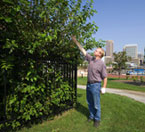 Real-Life Time Tunnel Looks 50 Years Ahead - In Maryland, ARS plant physiologist Lew Ziska has findings that show that noxious weeds like ragweed are already outcompeting more desirable plants.
Real-Life Time Tunnel Looks 50 Years Ahead - In Maryland, ARS plant physiologist Lew Ziska has findings that show that noxious weeds like ragweed are already outcompeting more desirable plants.
Ziska and former colleague Kate George have been using the "heat island" effects of Baltimore, Maryland, as a surrogate for a future warming in suburban and rural areas. In their own unique twist on a natural way to factor in rising temperatures, they have been studying plants growing in a transect from the heat of the City of Baltimore to the rural area outside of Frederick, Maryland, with a Baltimore suburban area in-between.
Agricultural Research magazine, November 2009 Complete Article(scroll down to "Real-Life Time Tunnel.."
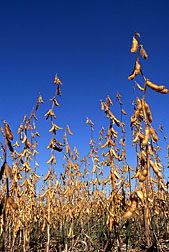 Extreme Weather Boosts Antioxidant Levels in Soybean Seeds - New findings suggest that weather and climate play key roles in the antioxidant levels of soybeans. Tocopherols are a family of antioxidants that protect biological membranes. In this family, alpha-tocopherol is the active form of vitamin E in humans, and soybean seeds are a major source of dietary tocopherol. Researchers analyzed the content of tocopherols in soybean seeds grown at several locations in Maryland between 1999 and 2002.
Extreme Weather Boosts Antioxidant Levels in Soybean Seeds - New findings suggest that weather and climate play key roles in the antioxidant levels of soybeans. Tocopherols are a family of antioxidants that protect biological membranes. In this family, alpha-tocopherol is the active form of vitamin E in humans, and soybean seeds are a major source of dietary tocopherol. Researchers analyzed the content of tocopherols in soybean seeds grown at several locations in Maryland between 1999 and 2002.
Agricultural Research magazine, August 2009 Complete Article
Nutrition
 Caffeine-Containing Botanicals in Dietary Supplements - An estimated 50 percent of adults in the United States report that they consume dietary supplements on a regular basis. Some of these supplements contain caffeine-even if it is not listed on the label as an ingredient. To explore caffeine levels in segments of the U.S. dietary supplement market, researchers with the ARS Nutrient Data Laboratory (NDL) analyzed a number of caffeine-containing products in 2004-2005.
Caffeine-Containing Botanicals in Dietary Supplements - An estimated 50 percent of adults in the United States report that they consume dietary supplements on a regular basis. Some of these supplements contain caffeine-even if it is not listed on the label as an ingredient. To explore caffeine levels in segments of the U.S. dietary supplement market, researchers with the ARS Nutrient Data Laboratory (NDL) analyzed a number of caffeine-containing products in 2004-2005.
Agricultural Research magazine, April 2009 Complete Article
 New Values for Vitamin D in Foods - Vitamin D is essential for maintaining strong bones. And researchers continue to explore additional ways that vitamin D is important to human health. Now the scientific community is focusing attention on the need to assess the dietary intake of vitamin D in the United States.
New Values for Vitamin D in Foods - Vitamin D is essential for maintaining strong bones. And researchers continue to explore additional ways that vitamin D is important to human health. Now the scientific community is focusing attention on the need to assess the dietary intake of vitamin D in the United States.
To determine how much vitamin D folks are getting in their diets, experts must know how much is in foods and beverages. At the ARS Beltsville Human Nutrition Research Center (BHNRC), researchers are working to provide new analytical values for foods believed to be good sources of vitamin D in the U.S. diet.
Agricultural Research magazine, May 2009 Complete Article
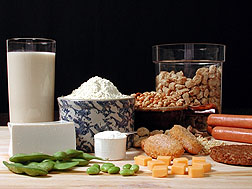 Database of Isoflavones in Foods Updated - A newly updated food composition database of plant chemical compounds called "isoflavones" has been launched. Isoflavones are found mainly in soybeans and soybean products and have mild estrogenlike properties and other biological attributes that may reduce the risk of some chronic diseases. The new database provides analytical values for three individual isoflavone compounds-genistein, daidzein, and glycitein-in nearly 550 foods.
Database of Isoflavones in Foods Updated - A newly updated food composition database of plant chemical compounds called "isoflavones" has been launched. Isoflavones are found mainly in soybeans and soybean products and have mild estrogenlike properties and other biological attributes that may reduce the risk of some chronic diseases. The new database provides analytical values for three individual isoflavone compounds-genistein, daidzein, and glycitein-in nearly 550 foods.
In assembling the database, the researchers conducted an extensive review of various data sources and evaluated scientific articles published in peer-reviewed journals since 1999. The Isoflavone Database is one of several "Special Interest Databases" produced by the ARS Nutrition Data Laboratory (NDL) to provide data on bioactive compounds for selected foods. Others include the Flavonoid, Proanthocyanidin, and ORAC databases.
The Special Interest Databases complement the NDL's core product-the National Nutrient Database for Standard Reference-which is the major authoritative source of food composition information in the United States. The new Isoflavone Database can be accessed online at: www.ars.usda.gov/nutrientdata/isoflav.
David B. Haytowitz, USDA-ARS Nutrient Data Laboratory, Beltsville, Maryland; phone (301) 504-0714
Agricultural Research magazine, April 2009
Sustainable Farming
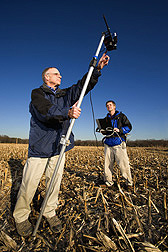 Spying on Crop Residue - Craig Daughtry and Paul Doraiswamy are developing techniques to figure out from satellite sensors how much of America's croplands are being farmed using conservation tillage or reduced tillage. They are also developing techniques for using satellite sensors and GIS (Geographic Information Systems) to identify farm fields that can sustain more residue removal for ethanol production without harm.
Spying on Crop Residue - Craig Daughtry and Paul Doraiswamy are developing techniques to figure out from satellite sensors how much of America's croplands are being farmed using conservation tillage or reduced tillage. They are also developing techniques for using satellite sensors and GIS (Geographic Information Systems) to identify farm fields that can sustain more residue removal for ethanol production without harm.
Agricultural Research magazine, April 2009 Complete Article
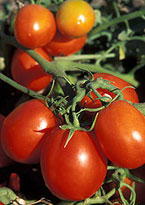 Hairy Vetch Boosts Tomato Phytonutrients - Members of the Vicia genus known as "hairy vetch" are viny, moderately winter-hardy legumes that are often grown to stabilize roadbanks or to serve as forage for grazing animals. Since they fix atmospheric nitrogen, they are a rich source of that critical plant nutrient.
Hairy Vetch Boosts Tomato Phytonutrients - Members of the Vicia genus known as "hairy vetch" are viny, moderately winter-hardy legumes that are often grown to stabilize roadbanks or to serve as forage for grazing animals. Since they fix atmospheric nitrogen, they are a rich source of that critical plant nutrient.
Now research has shown that planting tomatoes in fields of killed and rolled hairy vetch, which serves as a mulch, activates some of the metabolic pathways and genes that make tomato plants more vigorous-and their fruit more tasty and nutritious. The effect is similar to that obtained by inserting the ySAMdc gene into tomato plants, which is known to increase production of polyamines.
Agricultural Research magazine, October 2009 Complete Article(scroll down to "Hairy Vetch Boosts...")
Genomics
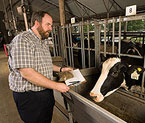 Breeding and Genetic Change in the Holstein Genome - The average American dairy cow produces more than 20,000 pounds of milk every year. Most of these cattle are Holsteins, a breed whose naturally high milk yield has been enhanced by decades of selective breeding.
Breeding and Genetic Change in the Holstein Genome - The average American dairy cow produces more than 20,000 pounds of milk every year. Most of these cattle are Holsteins, a breed whose naturally high milk yield has been enhanced by decades of selective breeding.
The U.S. dairy industry intensified selective-breeding efforts in the 1960s. Since then, the average milk yield in Holsteins has doubled, but there has also been a substantial reduction in fertility. Recent research by scientists at the Agricultural Research Service's Animal and Natural Resources Institute (ANRI) in Beltsville, Maryland, and the University of Minnesota (UM) suggests there may be a genetic connection between increased milk yields and reduced fertility.
Agricultural Research magazine, October 2009 Complete Article
Research to Save the Chesapeake Bay
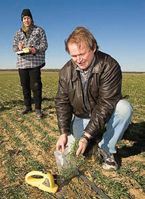 Cleaning the Chesapeake - Planting winter cover crops is an important management practice for reducing agricultural nutrient losses into the Chesapeake Bay and improving ecosystem health. The State of Maryland alone has doubled its budget for its cover crop cost-share program to $18 million in 2008-2009. This will provide for more than 387,000 acres of cover crops with no fall fertilization. Complete Article (scroll down to "Cleaning the Chesapeake")
Cleaning the Chesapeake - Planting winter cover crops is an important management practice for reducing agricultural nutrient losses into the Chesapeake Bay and improving ecosystem health. The State of Maryland alone has doubled its budget for its cover crop cost-share program to $18 million in 2008-2009. This will provide for more than 387,000 acres of cover crops with no fall fertilization. Complete Article (scroll down to "Cleaning the Chesapeake")
Insect Pests
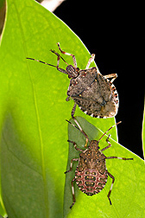 Combating the Brown Marmorated Stink Bug, A New Threat for Agriculture, a Nuisance for Homeowners - Halyomorpha halys, a native of Asia, has been expanding its range since its U.S. discovery in Allentown, Pennsylvania, 8 years ago. It has since been detected in portions of Virginia, West Virginia, New Jersey, Delaware, and Oregon, has infested houses in Maryland, and is showing up in increasing numbers in ARS traps in Beltsville, Maryland.
Combating the Brown Marmorated Stink Bug, A New Threat for Agriculture, a Nuisance for Homeowners - Halyomorpha halys, a native of Asia, has been expanding its range since its U.S. discovery in Allentown, Pennsylvania, 8 years ago. It has since been detected in portions of Virginia, West Virginia, New Jersey, Delaware, and Oregon, has infested houses in Maryland, and is showing up in increasing numbers in ARS traps in Beltsville, Maryland.
Jeffrey Aldrich, an entomologist and expert on stink bugs at the ARS Invasive Insect Biocontrol and Behavior Laboratory in Beltsville, is developing a weapon that will use the insect's own body chemistry: a pheromone-based trap.
Agricultural Research magazine, July 2009 Complete Article
 Working After Hours, A Nighttime View of Insect Predation - Growers have much to consider when protecting crops from insect pests. Determining which insects are threats to a crop entails effective sampling to get a good count of the species and life stages of pests and the beneficial insects that prey on them. Natural enemies of crop pests can help growers when efforts are made to conserve and increase their numbers.
Working After Hours, A Nighttime View of Insect Predation - Growers have much to consider when protecting crops from insect pests. Determining which insects are threats to a crop entails effective sampling to get a good count of the species and life stages of pests and the beneficial insects that prey on them. Natural enemies of crop pests can help growers when efforts are made to conserve and increase their numbers.
It's becoming apparent that daytime sampling of pests and beneficial insects doesn't present the full picture for effective natural pest control. Now, thanks to ARS researchers, nocturnal insect activity, particularly beneficial predation, is getting the attention it deserves as an important part of the biological-control puzzle.
Agricultural Research magazine, October 2009 Complete Article
Biodegradable Plastic
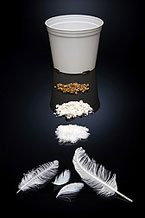 Feathers Can Be for More Than Pillow Stuffin' - ARS chemist Walter Schmidt, in the Environmental Management and Byproduct Utilization Laboratory in Beltsville, Maryland, develops practical uses for discarded chicken feathers. About 4 billion pounds of feathers are generated each year during the poultry production process.
Feathers Can Be for More Than Pillow Stuffin' - ARS chemist Walter Schmidt, in the Environmental Management and Byproduct Utilization Laboratory in Beltsville, Maryland, develops practical uses for discarded chicken feathers. About 4 billion pounds of feathers are generated each year during the poultry production process.
In 1998, ARS published its first story about Schmidt's research-using chicken feather fiber in the formation of plastics. Schmidt's persistence has paid off. In collaboration with the Horticultural Research Institute (HRI)-the research and development endowment of the American Nursery and Landscape Association, based in Washington, D.C.-Schmidt and HRI research associate Masud Huda have formulated planting pots that can degrade over variable periods of time-from 1 to 5 years.
Agricultural Research magazine, August 2009 Complete Article
Weed Control
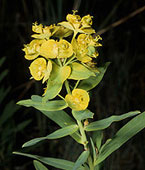 Knowing Where To Look for Infestations of Leafy Spurge - Using NASA's advanced hyperspectral sensor, the Airborne Visible Infrared Imaging Spectrometer (AVIRIS), Raymond Hunt and colleagues have developed and tested a new method for locating leafy spurge (Euphorbia esula), a noxious invasive weed that causes more than $200 million a year in losses in the Great Plains and western United States.
Knowing Where To Look for Infestations of Leafy Spurge - Using NASA's advanced hyperspectral sensor, the Airborne Visible Infrared Imaging Spectrometer (AVIRIS), Raymond Hunt and colleagues have developed and tested a new method for locating leafy spurge (Euphorbia esula), a noxious invasive weed that causes more than $200 million a year in losses in the Great Plains and western United States.
Agricultural Research magazine, April 2009 Complete Article
 Why Rye Cover Crops Are Great Natural Weed Killers - John Teasdale is trying to answer a question that might seem obvious: Why does rye work as a cover crop? Rye suppresses weeds without herbicides, making it a common cover crop on organic farms.
Why Rye Cover Crops Are Great Natural Weed Killers - John Teasdale is trying to answer a question that might seem obvious: Why does rye work as a cover crop? Rye suppresses weeds without herbicides, making it a common cover crop on organic farms.
The mechanics of how it works seem simple enough. When cut down and flattened on the soil, rye stalks block sunlight and prevent germinating weeds from getting the light they need. Rye's root system also captures nutrients and holds the soil, preventing erosion and making it particularly attractive to farmers in the Chesapeake Bay watershed and other areas where runoff is a concern. It also grows at cold temperatures, making it ideal for fall planting and winter growth.
Agricultural Research magazine, October 2009 Complete Article
Animal Health
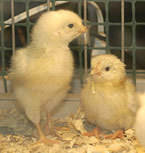 The Poultry Pantry: Plums, Probiotics, Safflower, and Tea - Agricultural Research Service immunologist Hyun Lillehoj has been working with colleagues in the agency and around the world to find ways of strengthening the poultry immune system with dietary supplements.
The Poultry Pantry: Plums, Probiotics, Safflower, and Tea - Agricultural Research Service immunologist Hyun Lillehoj has been working with colleagues in the agency and around the world to find ways of strengthening the poultry immune system with dietary supplements.
Boosting bird health helps poultry ward off the effects of avian coccidiosis, a disease estimated to cost producers worldwide more than $1.2 billion every year. Chickens and other birds develop the disease after becoming infected with the parasite Eimeria. As drug-resistant strains of the pathogen evolve, producers are anxious to find alternative control methods to current drug protocols.
Agricultural Research magazine, May 2009 Complete Article
Crop Diversity
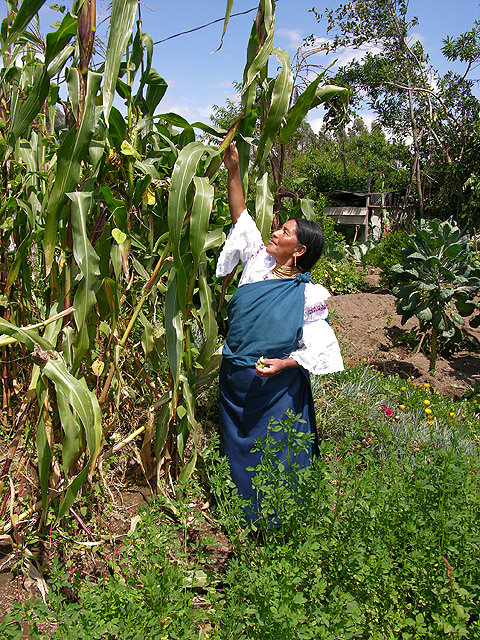 Conserving Crop Diversity and a Way of Life in Ecuador - Can conservation of traditional crops, in an area considered one of the cradles of world agriculture, contribute to the livelihoods of the local people? An ARS researcher is working with an international team of scientists to do just that in rural indigenous communities in Ecuador.
Conserving Crop Diversity and a Way of Life in Ecuador - Can conservation of traditional crops, in an area considered one of the cradles of world agriculture, contribute to the livelihoods of the local people? An ARS researcher is working with an international team of scientists to do just that in rural indigenous communities in Ecuador.
Agricultural Research magazine, August 2009 Complete Article
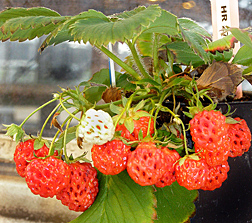 Gender Evolution in Strawberries, The Doorway to Enhanced Productivity - It's no surprise that strawberries are the most popular type of berry fruit in the world. This sweet, juicy, refreshing fruit is the perfect snack or end to any meal, especially on a hot summer day. But have you ever wished you could eat locally grown strawberries all year round? Well, new Agricultural Research Service research brings us one step closer.
Gender Evolution in Strawberries, The Doorway to Enhanced Productivity - It's no surprise that strawberries are the most popular type of berry fruit in the world. This sweet, juicy, refreshing fruit is the perfect snack or end to any meal, especially on a hot summer day. But have you ever wished you could eat locally grown strawberries all year round? Well, new Agricultural Research Service research brings us one step closer.
Agricultural Research magazine, August 2009 Complete Article
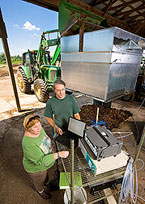 A Multifaceted Focus on Farms and Food - The project is a cartographer's dream: a map that melds layer upon layer of digital information to compile a comprehensive picture of the potential for local food production all along the eastern seaboard.
A Multifaceted Focus on Farms and Food - The project is a cartographer's dream: a map that melds layer upon layer of digital information to compile a comprehensive picture of the potential for local food production all along the eastern seaboard.
Going Local - Until recently, low fuel prices contributed to the globalization of the U.S. food system. Food is grown and processed in a limited range of regions and then transported over long distances to many different markets. The result? More than 65 percent of the vegetables and 80 percent of the fruit consumed in the eastern seaboard is produced and brought in from somewhere else.
The Complete Composters - In sustainable agriculture, every component counts. So at the ARS Environmental Management and Byproduct Utilization Laboratory in Beltsville, microbiologist Walter Mulbry is working on another piece in the matrix-recycling manure and discarded food to develop the perfect pile of compost.
Agricultural Research magazine, September 2009 Complete Article
